The “fly-half” or as our Kiwi friends would refer to it, the “first five-eighth”, is possibly the most pivotal position on the rugby pitch. Between being the key decision maker, managing and reading the game, it’s probably the position that comes with the most pressure.
We aim to provide a snapshot of fly-halves from the top eight teams according to the latest world rankings and compare each tens individual statistics.
While it will undoubtedly be argued that much of the skills a fly-half should possess are unquantifiable, the results appear to be pretty close to popular consensus. With that said, the following are the top eight ranked national rugby teams in the world.
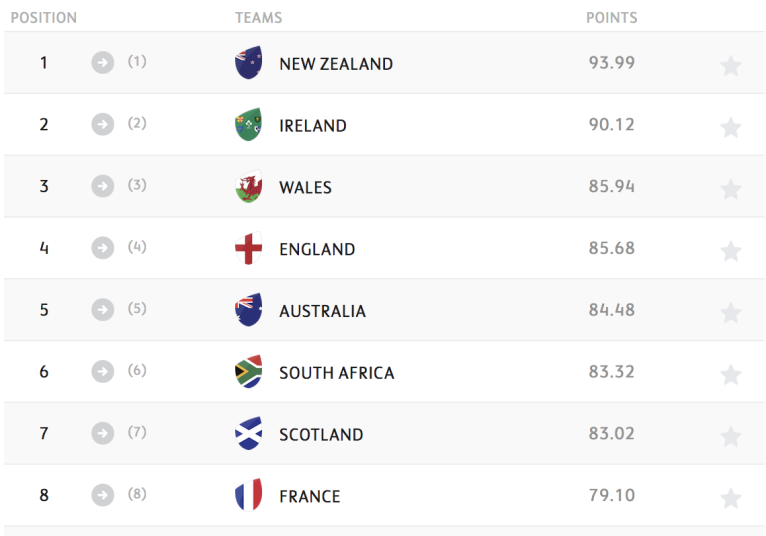
In order to do a comparison of fly-halves, it’s fairer to compare players over an equal amount of minutes played instead of on a game by game basis. The idea is to judge and compare their impact over a similar amount of time played.
Sexton only had 1301 minutes of international game time since 2016 which was the lowest of the top seven teams. Not hugely surprising given how vital he is to Ireland’s game. The Irish tend to wrap the 32-year-old in cotton wool for the majority of the year, only taking him down from the shelf when absolutely necessary.
French fly-halves accrued the least amount of minutes played, having to go back as far as the start of 2014, when Camille Lopes managed to string together 980 minutes. The top seven were all at least on 1300 minutes from the start of 2016 to now, with some even getting over 2000 minutes played in that time.
This points to France’s ongoing conundrum on who should be their main fly-half. Although we wanted as many minutes as possible, it was felt it would have been unfair not to include a French representative so the promising Anthony Belleau is thrown into the mix but the primary focus will be on the top seven.
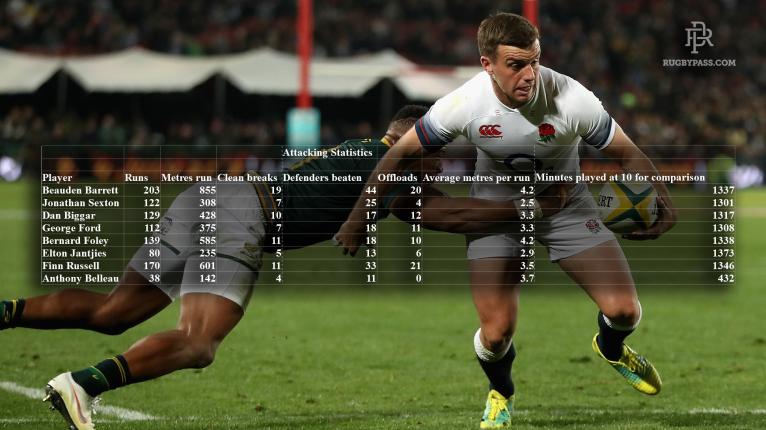
If we sat down and argued right now about who the best fly-half in the world is, chances are we would eventually settle on Beauden Barrett.
Granted he is just 30 minutes over the minimum of minutes played that we were looking for, but his numbers are phenomenally impressive. Topping pretty much every area in attacking statistics with 203 runs, 855 metres run, 19 clean breaks, 44 defenders beaten, 20 offloads and an average amount of metres per run of 4.2 metres over 1337 minutes.
Impressively Foley managed to tie Barrett for the average metres per run with 4.2m also over a nearly identical 1338 minutes played.
Finn Russell has the most offloads with 21, just about pipping Barrett’s 20. He has the 2nd most defenders beaten with 33 and is tied for 2nd in terms of clean breaks with Foley at 11. Russell also has a very respectable 3.5m per run on average over 1346 minutes.
Sexton has the lowest amount of offloads made at just 4 but that’s more indicative of Ireland’s playing style. The most disappointing attacking display seems to be Jantjies in this comparison. Jantjies made only 5 clean breaks, 13 defenders beaten, 6 offloads and an average of 2.9m per run over 1373 minutes.
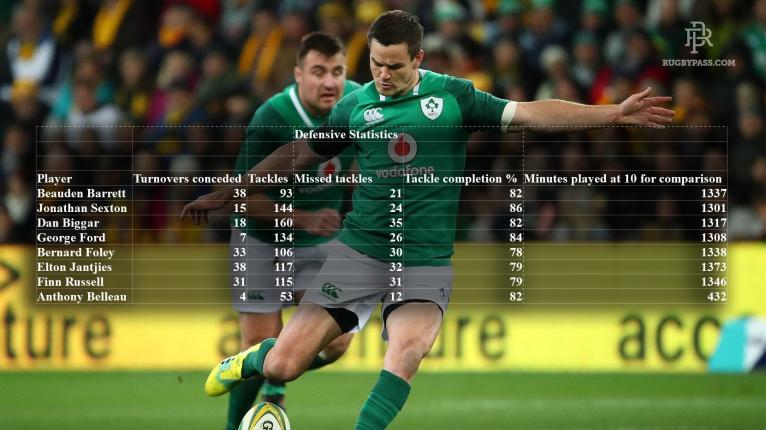
Moving to the defensive side of things, Sexton comes out with the 2nd most tackles made but has the best tackle completion percentage of 86%. He also has the 2nd lowest amount of turnovers conceded at just 15.
George Ford has a miserly 7 turnovers conceded and the 2nd best tackle completion percentage with 84% over 1308 minutes.
Barrett is actually tied with Jantjies for the most turnovers conceded with 38, somewhat surprising. Foley has the worst tackle completion percentage with 78% over 1338 minutes. Jantjies and Russell also have poor tackle completion percentages with 79% each.
Surprisingly Biggar has the most tackles made in this comparison with 160 and a tackle success rate of 82%. He also has a relatively low amount of turnovers conceded in an impressive defensive performance over 1317 minutes.
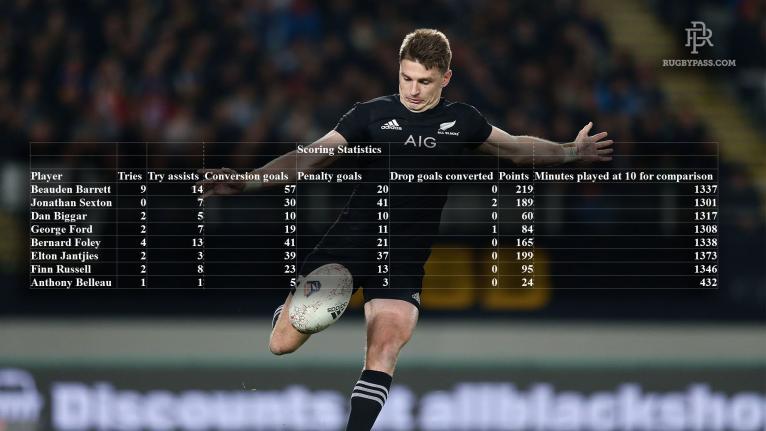
Unsurprisingly, Barrett tops the try charts with 9 tries and 14 try assists, indicative of New Zealand’s prowess when it comes to tries, finding himself on top of the pile with 57 conversions scored.
Ireland are known to be a complete menace at the breakdown resulting in indiscipline from opponents and it shows up here, as Sexton finds himself with the most penalties scored.
Regarding the small number of penalties scored by Biggar, Ford and Russell, this seems to be a result of having at times Halfpenny, Farrell and Laidlaw being the designated kickers.
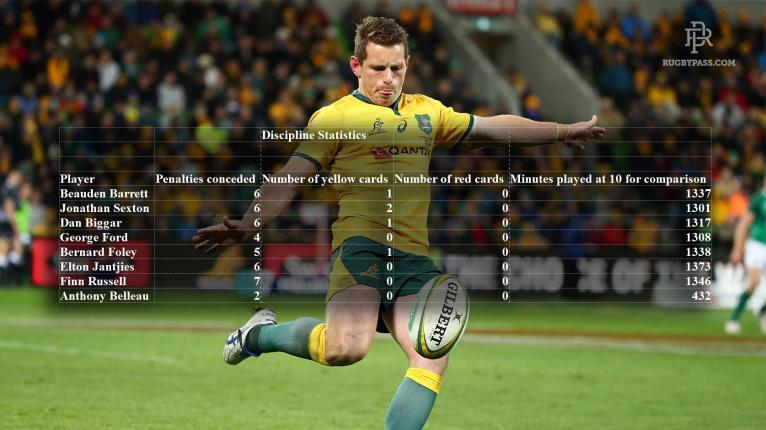
Ford, the most impressive ten when it comes to discipline in this comparison, with only 4 penalties conceded and no cards over 1308 minutes. Unsurprisingly Sexton has 2 yellow cards, the most of the top seven teams. There isn’t a huge difference in terms of penalties conceded in this comparison from the fly-halves but Russell tops the penalties conceded with a total of 7.
From the stats, it’s safe to say that Beauden Barrett is far and away the best-attacking fly-half and Jonathan Sexton the best defensive fly-half in the world.
Seems about right.







































Comments on RugbyPass
Exeter were thumped by 38 points. And they only had to hop on a train.
30 Go to commentsI am De Groot.
1 Go to commentsHad hoped you might write an article on this game, Nick. It’s a good one. Things have not gone as smoothly for ROG since beating Leinster last year at the Aviva in the CC final. LAR had the Top 14 Final won till Raymond Rhule missed a simple tackle on the excellent Ntamack, and Toulouse reaped the rewards of just staying in the fight till the death. Then the disruption of the RWC this season. LAR have not handled that well, but they were not alone, and we saw Pau heading the Top 14 table at one stage early season. I would think one of the reasons for the poor showing would have to be that the younger players coming through, and the more mature amongst the group outside the top 25/30, are not as strong as would be hoped for. I note that Romain Sazy retired at the end of last season. He had been with LAR since 2010, and was thus one of their foundation players when they were promoted to Top 14. Records show he ended up with 336 games played with LAR. That is some experience, some rock in the team. He has been replaced for the most part by Ultan Dillane. At 30, Dillane is not young, but given the chances, he may be a fair enough replacement for Sazy. But that won’be for more than a few years. I honestly know little of the pathways into the LAR setup from within France. I did read somewhere a couple of years ago that on the way up to Top 14, the club very successfully picked up players from the academies of other French teams who were not offered places by those teams. These guys were often great signings…can’t find the article right now, so can’t name any….but the Tadgh Beirne type players. So all in all, it will be interesting to see where the replacements for all the older players come from. Only Lleyd’s and Rhule from SA currently, both backs. So maybe a few SA forwards ?? By contrast, Leinster have a pretty clear line of good players coming through in the majority of positions. Props maybe a weak spot ? And they are very fleet footed and shrewd in appointing very good coaches. Or maybe it is also true that very good coaches do very well in the Leinster setup. So, Nick, I would fully concurr that “On the evidence of Saturday’s semi-final between the two clubs, the rebuild in the Bay of Biscay is going to take longer than it is on the east coast of Ireland”
11 Go to commentsWhat was the excuse for the other knockout blowouts then? Does the result not prove the Saints were just so much better? Wise call to put your eggs in one basket when you’ve got 2 comps simultaneously finishing.
30 Go to commentsReally hope Kuruvoli and his partner rock the Canes.
1 Go to commentsI wonder what impact Samson has had on their attack, as the team seems less prone to trundle it up the middle, take the tackle and then trundle it up again. I lost faith in the coach last year as the Rebelss looked like a 2nd/3rd rate South African team. I also disliked Gordon standing back, often ignored as the forward battle went on and on. Maybe its our Aussie way of not getting off our A***’s until the enemy is at the gate.
86 Go to commentsThanks for the write up. Great to see the Rebs winning, I am a little interested in how they will go against the remaining kiwi teams, I think they’ve only played Hurricanes and Highlanders but how great to see these players performing!! I also see Parling has a job beyond June 30! A good move by RA? Also how do you fix the Rebels previously scratchy defence?
86 Go to commentsbe smart - go black
13 Go to commentsNext week the Crusaders hopefully have Scott Barrett back. Will be great to have the captain back. Hopefully he will be the All Black captain as well.
12 Go to commentsExciting place to be for the young fella. I expected he was French Polynesian when I saw him included in the France 6N squad (after seeing him in NZs), and therefor be strong grounds we might loose him to rugby down here. Good, in that he is good enough to warrant such a profile, and from a journalism’s fan interaction aspect, to finally get a back ground story on the fella. Hope he has settled into NZ OK and that at least one rugby country will fit with him to help his development, which, if so, he should surely continue for a few years, and then that he can experience France to it’s fullest with a bit more maturity and less reliance on family than you would have at his current age. A good 3 or 4 years before he would be ready for International duty if he wanted to wait. Of course he already sounds good enough to accept a call up, and to cap himself, in the more immediate future (he’d have to be very very good in the case of the ABs), and he’ll get a great taste of that being with the Canes who have a bunch who are just a few years further into their career and looking likely Internationals themselves.
13 Go to commentsI remember towards the end of the original broadcasting deal for Super rugby with Newscorp that there was talk about the competition expanding to improve negotiations for more money - more content, more cash. Professional rugby was still in its infancy then and I held an opposing view that if Super rugby was a truly valuable competition then it should attract more broadcasters to bid for the rights, thereby increasing the value without needing to add more teams and games. Unfortunately since the game turned professional, the tension between club, talent and country has only grown further. I would argue we’re already at a point in time where the present is the future. The only international competitions that matter are 6N, RC and RWC. The inter-hemisphere tours are only developmental for those competitions. The games that increasingly matter more to fans, sponsors and broadcasters are between the clubs. Particularly for European fans, there are multiple competitions to follow your teams fortunes every week. SA is not Europe but competes in a single continental competition, so the travel component will always be an impediment. It was worse in the bloated days of Super rugby when teams traversed between four continents - Africa, America, Asia and Australia. The percentage of players who represent their country is less than 5% of the professional player base, so the sense of sacrifice isn’t as strong a motivation for the rest who are more focused on playing professional rugby and earning as much from their body as they can. Rugby like cricket created the conundrum it’s constantly fighting a losing battle with.
5 Go to commentsOh wow… “But as La Rochelle proved in winning in Cape Town this season, a cross-continental away assignment need not spell the end of days.” La Rochelle actually proved quite the opposite. After traveling to Cape town and back they (back-to-back and current champs) got mercilessly thumped the next week. If travel is not the reason, why else would a full-strength powerhouse like La Rochelle get dumped on their @r$e$ one week later?
30 Go to commentsYou know he can land a winning conversion after the full time siren is up. (Even if it takes two attempts.)
5 Go to commentsA very insightful article from Jake. I would love to know how South African’s feel about their move to Europe. Do you prefer playing in Europe or want to go back to Super Rugby?
5 Go to commentspure fire
1 Go to commentsA very well thought out summary of all the relevant complications…agree with your ”refer the Cricket Test versus 20/20 comparison”. More also definitely doesn't necessarily mean better!
5 Go to commentsMust be something when you are only 19 y.o and both NZ and France want you. Btw he wasn’t the only new caledonian in french U20 as Robin Couly also lived in Noumea until 17. Hope he’s successful wherever he chooses to play.
13 Go to comments“Several key players in the Stade Rochelais squad are in their thirties” South Africans are going to hate the implications of that comment!
11 Go to commentsI know Leinster did a job on La Roche but shortly after HT Leinster were 30-13 ahead of them and at a similar time Toulouse were trailing Exeter. At 60 mins Leinster were 27 ahead but after 67 mins Toulouse were only 19 ahead before Exeter collapsed. That’s heavier scoring by Leinster against the Champions. I think people are looking at Toulouses total a little too much. I also think Northhampton are in with a real chance, albeit I’d put Leinster as favourites. If Leinster make the final I expect them to win by more than ten and with control.
11 Go to commentsHey Nick, your match analysis is decent but the top and tail not so much, a bit more random. For a start there’s a seismic difference in regenerating any club side over a test team. EJ pretty much had to urinate with the appendage he’d been given at test level whereas club success is impacted hugely by the budget. Look no further than Boudjellal’s Toulon project for a perfect example. The set ups at La Rochelle and Leinster are like chalk and cheese and you are correct that Leinster are ahead. Leinster are not just slightly ahead though, they are light years ahead on their plans, with the next gen champions cup team already blooded, seasoned and developing at speed from their time manning the fort in the URC while the cream play CC and tests. They have engineered a strong talent conveyor belt into their system, supported by private money funnelled into a couple of Leinster private schools. The really smart move from Leinster and the IRFU however is maximising the Irish Revenue tax breaks (tax relief on the best 10 years earnings refunded at retirement) to help keep all of their stars in Ireland and happy, while simultaneously funding marquee players consistently. And of course Barrett is the latest example. But in no way is he a “replacement for Henshaw”, he’s only there for one season!!! As for Rob Baxter, the best advice you can give him is to start lobbying Parliament and HMRC for a similar state subsidy, but don’t hold your breath… One thing Cullen has been very smart with is his coaching team. Very quickly he realised his need to supplement his skills, there was talk of him exiting after his first couple of years but he was extremely shrewd bringing in Lancaster and now Nienaber. That has worked superbly and added a layer that really has made a tangible difference. Apart from that you were bang on the money… 😉😂
11 Go to comments